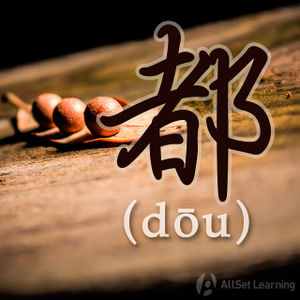Difference between revisions of "Expressing "every time" with "mei" and "dou""
| Line 1: | Line 1: | ||
{{Grammar Box}} | {{Grammar Box}} | ||
| − | "每...都..." (měi...dōu...) is a pattern used to express "every" when talking about a quantitative amount. | + | "每...都..." (měi...dōu...) is a pattern used to express "every" when talking about a quantitative amount. This is similar to how we say "every day I eat cereal" or "every student passed the exam。“ |
| − | == | + | == Using 每...都 to mean "every" == |
| − | + | Using 没 and 都 together is pretty simple. | |
<div class="jiegou"> | <div class="jiegou"> | ||
| Line 15: | Line 15: | ||
An important note is that if the number is simply just "one", then it's usually omitted. | An important note is that if the number is simply just "one", then it's usually omitted. | ||
| − | == Examples == | + | === Examples === |
<div class="liju"> | <div class="liju"> | ||
| − | *我 <em>每</em> 个 星期 三 都 去 实习。 | + | *我 <em>每</em> (一) 个 星期 三 都 去 实习。 |
| − | *他 <em>每</em> 天 <em>都</em> 上 班。 | + | *他 <em>每</em> (一) 天 <em>都</em> 上 班。 |
*请 你 <em>每</em> 两 天 服 一 次 药。 | *请 你 <em>每</em> 两 天 服 一 次 药。 | ||
</div> | </div> | ||
| − | + | Just make sure that when you went to express "every one" with 每, as in "every day I take a nap", ''don't'' forget the 都! | |
| − | In this grammar structure, we focus on every time a certain action is done, like "every time I eat chili I feel happy | + | |
| + | == Using 每 and 都 when focusing on a certain action == | ||
| + | |||
| + | In this grammar structure, we focus on every time a certain action is done, like "every time I eat chili I feel happy." | ||
<div class="jiegou"> | <div class="jiegou"> | ||
| Line 35: | Line 38: | ||
</div> | </div> | ||
| − | == Examples == | + | === Examples === |
<div class="liju"> | <div class="liju"> | ||
*她 <em>每</em> <strong>说</strong> 一 句 话 <em>都</em> 要 停 一下。 | *她 <em>每</em> <strong>说</strong> 一 句 话 <em>都</em> 要 停 一下。 | ||
| − | *我 <em>每</em> <strong>看完</strong> 一部电影 <em>都</em> | + | *我 <em>每</em> <strong>看完</strong> 一部电影 <em>都</em> 想 跟 他讨论。 |
</div> | </div> | ||
Revision as of 08:45, 12 March 2013
-
Level
-
Similar to
-
Used for
-
Keywords
"每...都..." (měi...dōu...) is a pattern used to express "every" when talking about a quantitative amount. This is similar to how we say "every day I eat cereal" or "every student passed the exam。“
Contents
Using 每...都 to mean "every"
Using 没 and 都 together is pretty simple.
每 + Number + Measure Word + Noun + 都 + Adjective/Verb
An important note is that if the number is simply just "one", then it's usually omitted.
Examples
- 我 每 (一) 个 星期 三 都 去 实习。
- 他 每 (一) 天 都 上 班。
- 请 你 每 两 天 服 一 次 药。
Just make sure that when you went to express "every one" with 每, as in "every day I take a nap", don't forget the 都!
Using 每 and 都 when focusing on a certain action
In this grammar structure, we focus on every time a certain action is done, like "every time I eat chili I feel happy."
每 +Verb + Number+ 都 + Adjective/Verb
Examples
- 她 每 说 一 句 话 都 要 停 一下。
- 我 每 看完 一部电影 都 想 跟 他讨论。
See also
Sources and further reading
Books
- Chinese: An Essential Grammar, Second Edition (pp. 87-8) →buy
- Integrated Chinese: Level 1, Part 1 (3rd ed) (pp. 267) →buy
- Modern Mandarin Chinese Grammar: A Practical Guide (pp. 284-5) →buy



